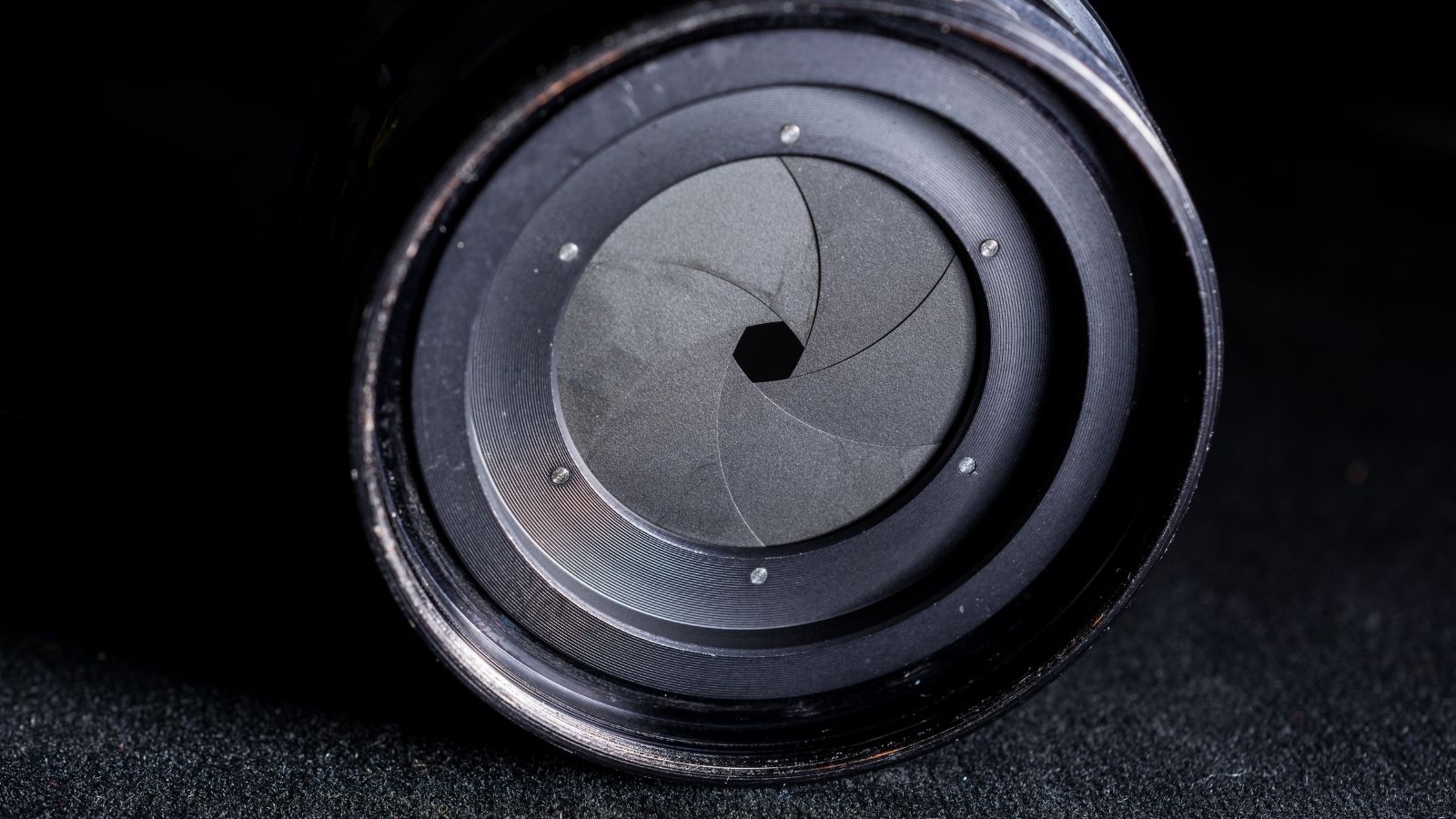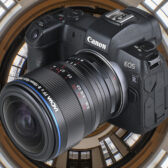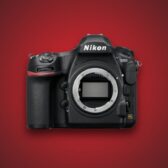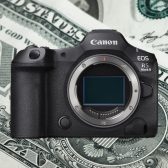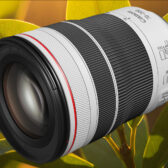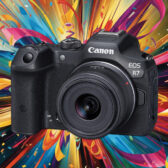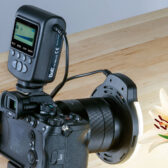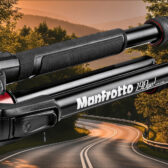The term “aperture” sounds like either a spaceship part or a hipster baby name. It’s a portal to visual storytelling, a tool that shapes how your photo feels. From buttery bokeh to pin-sharp panoramas, aperture helps you guide the viewer’s eye and paint with light.
It’s the light gatekeeper. Use it to sculpt your style, play with mood, and bend the light to your will like a shutter-slinging Gandalf.
Let’s get into the know-how of it, shall we?
Chapter 1: So… What Is Aperture?
Aperture is a small, adjustable opening inside your lens that controls how much light hits your camera sensor. Yep, just a hole. It controls how much light gets in when you take a photo. Imagine your camera lens is a robotic eye. The aperture is its pupil, and just like your own peepers, it expands and contracts depending on the light.
More light needed? It opens wide like it just saw a ghost. Too much light? It narrows down like it’s squinting into the sun on a hangover morning.
Chapter 2: F-Stops, or Why Photographers Talk Like Jedi Masters
Aperture is measured in f-stops.
These look like this:
f/1.8, f/2.8, f/4, f/5.6, f/8, f/11, f/16… you get the idea.
Here’s the backwards sorcery part:
The LOWER the f-number, the WIDER the hole.
The HIGHER the f-number, the SMALLER the hole.
So f/1.4 is basically the “firehose” setting—TONS of light blasting in. And f/22 is more like “pinprick”—just a trickle of light.
This is because the “f” in f-stop stands for focal length, and the number is a ratio:
Aperture = focal length / diameter of the aperture.
So f/2 on a 50mm lens means a 25mm wide opening (50 ÷ 2).
The f-stop scale isn’t random either. Each full stop (f/2 to f/2.8, f/2.8 to f/4, etc.) halves the amount of light that enters the camera. That’s right—every jump in f-stop = 50% less light. It’s like dimming a smart bulb in perfect mathematical increments.
Chapter 3: Aperture vs. Light
Why does light matter so much? Because photography is literally the art of capturing light. The word “photo-graphy” translates to “drawing with light.” Aperture determines how bold or subtle your light drawing is.
Why does light matter so much? Because photography is literally the art of capturing light. The word “photo-graphy” translates to “drawing with light.” Aperture determines how bold or subtle your light drawing is.
When shooting in a dim room or at night, you want more light to reach the sensor. So, you open up the aperture (low f-number).
On a bright day at the beach? You’ll want to stop down (raise the f-number) so your photos don’t look like they were taken inside the sun.
You know those moody, low-light shots where the background melts away into dreamy blur? That’s wide aperture (low f-number) at work. It lets in more light, which is perfect for:
- Night shots
- Indoor photos
- Dramatic portraits where your subject looks like a lonely poetry major
But crank that aperture smaller (high f-number), and you get:
- Crisp landscapes
- Everything in focus
- More detail than your Zoom camera wants you to have at 7 a.m.
Think of aperture as the DJ mixing the vibe between moody jazz club and crystal-clear afternoon picnic.
Chapter 4: Depth of Field – or Why Your Background is Blurry (on Purpose)
Here’s where the magic happens. Aperture controls depth of field, which is nerd-speak for how much of your photo is in focus.
- A wide aperture (f/1.4 – f/2.8) gives you a shallow depth of field. That means your subject is sharp, but the background turns into a soft, creamy blur. This is called bokeh (pronounced boh-kay), and photographers chase this look like it’s Pokémon Go 2016.
- A narrow aperture (f/11 – f/22) gives you deep depth of field. This keeps everything in focus—from the dandelion in the foreground to the UFO photobombing in the background.
Portraits usually lean on shallow depth for that cinematic, eyes-in-focus, background-is-a-dream aesthetic. Landscapes go the opposite way—crisp detail from here to the horizon.
Want artsy blurry backgrounds, aka “bokeh”? Go wide.
Want everything sharp like an IKEA instruction manual? Go narrow.
Chapter 5: Aperture, ISO, and Shutter Speed – The Nerdy Holy Trinity
Photography is basically a three-way tug-of-war between aperture, shutter speed, and ISO. These three form the Exposure Triangle, which is not a conspiracy theory but honestly feels like one sometimes.
- Aperture controls light and depth of field.
- Shutter speed controls how long the light hits the sensor (and how motion is captured).
- ISO controls how sensitive your camera is to light (and how grainy things get).
If you change one, the others have to compensate. It’s like balancing work, sleep, and social life. You can never have all three unless you’re a time wizard.
Chapter 6: Choosing the Right Aperture – A Choose-Your-Own-Adventure
Let’s say you’re out shooting:
Landscapes?
Go for f/8 to f/16. You want all that scenery in focus, from the flowers in the foreground to that tiny hiker photobombing your mountain.
Portraits?
f/1.8 to f/2.8. Make your subject pop while the background fades into a soft blur of mystery and unpaid parking tickets.
Street Photography?
f/5.6 to f/8. A nice middle ground where the action is sharp but still vibey.
Astrophotography?
Wide open baby. f/2.8 or wider. Let all that sweet starlight pour in like cosmic tea.
| F-Stop (Aperture) | Size | Light Intake | Depth of Field | Best For |
| f/1.4 – f/2.8 | Very Wide | Lots of Light | Very Shallow (blurry background) | Portraits, low-light, dreamy bokeh |
| f/4 – f/5.6 | Medium-Wide | Moderate | Moderate depth | Street, general use, casual portraits |
| f/8 – f/11 | Medium-Narrow | Less Light | Deep focus | Landscapes, group shots, sharp detail |
| f/16 – f/22 | Very Narrow | Minimal Light | Very Deep (everything sharp) | Bright scenes, architecture, macro |
Chapter 7: Common Aperture Mistakes
Let’s keep you from facepalming later:
- Overexposed Photos in Bright Sun: Wide aperture, too much light. Result: washed out images. Solution: crank up shutter speed or use an ND filter.
- Photos Too Dark Indoors: Narrow aperture, not enough light. Solution: open that aperture or boost ISO (careful, too high = grainy).
- Eyes Out of Focus in Portraits: With f/1.4, the depth of field is razor-thin. One blink or wiggle and you’ve got blurry eyeballs. Always focus on the eyes, and shoot a few just in case.
- Stopping Down Too Much: f/22 sounds cool, but diffraction (a nerdy light phenomenon) softens your image. Most lenses have a “sweet spot” around f/5.6–f/8 for sharpness.
Chapter 8: Aperture in Real Life
So, one day you’re fiddling with your DSLR, and you discover that dropping from f/4 to f/2 makes your photo go from “meh” to “moody indie album cover.” That’s the joy of aperture. It’s not just technical—it’s emotional.
Whether you’re chasing the golden hour or trying to make your dog look like a Vogue model, aperture is your best sidekick.
Final Chapter: Gear Talk – Lenses That Love the Light
Not all lenses are created equal. Some can open their aperture super wide (like f/1.4)—these are often called “fast lenses.” They’re great for low light and dramatic blur.
Others only go to f/4 or f/5.6, especially cheaper zoom lenses. Totally fine! Just know your tool.
If you’re building a kit, a 50mm f/1.8 prime lens is an amazing, budget-friendly piece of glass that turns you into a photo sorcerer.
In conclusion, aperture may seem like a tiny detail, but it holds the power to shape light, mood, and magic in your photos. Mastering it means turning snapshots into art.
Go forth and shoot, noble photon wrangler! May your exposures be perfect and your bokeh buttery.
|
When you purchase through links on our site, we may earn an affiliate commission. Here's how it works. |


